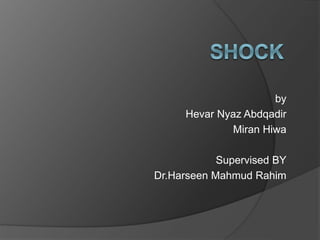SHOCK.pptx
•Als PPTX, PDF herunterladen•
0 gefällt mir•5 views
Content about human shock
Melden
Teilen
Melden
Teilen

Empfohlen
Empfohlen
Weitere ähnliche Inhalte
Ähnlich wie SHOCK.pptx
Ähnlich wie SHOCK.pptx (12)
Study on the Health Related Quality of Life of Patients with Ischemic stroke

Study on the Health Related Quality of Life of Patients with Ischemic stroke
https://nationalreporters.wordpress.com/2023/08/23/guidelines-forprevention-a...

https://nationalreporters.wordpress.com/2023/08/23/guidelines-forprevention-a...
Mehr von RabeaDia
Mehr von RabeaDia (17)
Adrenal glands.pdfmeningitis Focal suppurative CNS infections Subdural or epi...

Adrenal glands.pdfmeningitis Focal suppurative CNS infections Subdural or epi...
muscle diseases 4th year.F is formed by active secretion

muscle diseases 4th year.F is formed by active secretion
Association.pptxis method we have an x -ray machine, an intraoral sensor and ...

Association.pptxis method we have an x -ray machine, an intraoral sensor and ...
infectious-diseases -lec 1.pptGangrene is a clinical condition of ischemic an...

infectious-diseases -lec 1.pptGangrene is a clinical condition of ischemic an...
BRONCHIOLITIS 2022 PPT.pptxExamination of axilla: right axilla examine by lef...

BRONCHIOLITIS 2022 PPT.pptxExamination of axilla: right axilla examine by lef...
ASTHMA 2022 PPT.pptxExamination of axilla: right axilla examine by left hand ...

ASTHMA 2022 PPT.pptxExamination of axilla: right axilla examine by left hand ...
Kürzlich hochgeladen
Kürzlich hochgeladen (20)
Web & Social Media Analytics Previous Year Question Paper.pdf

Web & Social Media Analytics Previous Year Question Paper.pdf
Basic Civil Engineering first year Notes- Chapter 4 Building.pptx

Basic Civil Engineering first year Notes- Chapter 4 Building.pptx
Russian Escort Service in Delhi 11k Hotel Foreigner Russian Call Girls in Delhi

Russian Escort Service in Delhi 11k Hotel Foreigner Russian Call Girls in Delhi
Measures of Central Tendency: Mean, Median and Mode

Measures of Central Tendency: Mean, Median and Mode
Measures of Dispersion and Variability: Range, QD, AD and SD

Measures of Dispersion and Variability: Range, QD, AD and SD
Mixin Classes in Odoo 17 How to Extend Models Using Mixin Classes

Mixin Classes in Odoo 17 How to Extend Models Using Mixin Classes
SHOCK.pptx
- 1. by Hevar Nyaz Abdqadir Miran Hiwa Supervised BY Dr.Harseen Mahmud Rahim
- 2. Content What is shock? Types Of Shock What are the signs and symptoms of shock? What causes shock to occur? How is shock diagnosed? Can you fully recover from shock? Can shock be prevented?
- 3. Types Of Shock There are many types of shock. They fall under four main categories, based on what has affected the flow of blood. The four major types are: obstructive shock cardiogenic shock distributive shock hypovolemic shock
- 4. What is shock? Your body experiences shock when you don’t have enough blood circulating through your system to keep organs and tissues functioning properly. It can be caused by any injury or condition that affects the flow of blood through your body. Shock can lead to multiple organ failure as well as life-threatening complications.
- 5. What are the signs and symptoms of shock? If you go into shock, you may experience one or more of the following: rapid, weak, or absent pulse irregular heartbeat rapid, shallow breathing chest pain nausea confusion anxiety thirst and dry mouth low blood sugar loss of consciousness
- 6. What causes shock to occur? Anything that affects the flow of blood through your body can cause shock. Some causes of shock include: severe allergic reaction significant blood loss heart failure blood infections dehydration poisoning burns
- 7. How is shock diagnosed? external symptoms. low blood pressure weak pulse rapid heartbeat Imaging tests Your doctor may order imaging tests to check for injuries or damage to your internal tissues and organs, such as: bone fractures organ ruptures muscle or tendon tears abnormal growths Such tests include: ultrasound X-ray CT scan MRI scan
- 8. How is shock treated? treatment plan for shock will depend on the cause of your condition. Different types of shock are treated differently. For example, your doctor may use: epinephrine and other drugs to treat anaphylactic shock blood transfusion to replace lost blood and treat hypovolemic shock medications, heart surgery, or other interventions to treat cardiogenic shock antibiotics to treat septic shock
- 9. Can you fully recover from shock? Your chances of recovery and long-term outlook depend on many factors, including: the cause of shock the length of time you were in shock the area and extent of organ damage that you sustained the treatment and care that you received your age and medical history
- 10. Can shock be prevented? Some forms and cases of shock are preventable For example To lower your risk of blood loss from injuries, wear protective gear when taking part in contact sports, riding your bike, and using dangerous equipment. Wear a seatbelt when traveling in motor vehicles. To lower your chances of heart damage, eat a well-balanced diet, exercise regularly, and avoid smoking and secondhand smoke.
- 11. Reference International Trauma Life Support for Emergency Care Providers (8 ed.). Pearson Education Limited. 2018. pp. 172–173. ISBN 978-1292-17084-8. ATLS - Advanced Trauma Life Support - Student Course Manual (10 ed.). American College of Surgeons. 2018. pp. 43–52, 135. ISBN 978-78-0-9968267. Tabas, Jeffrey; Reynolds, Teri (2010). High Risk Emergencies, An Issue of Emergency Medicine Clinics - E-Book. Elsevier Health Sciences. p. 58. ISBN 978-1455700257. Smith, N; Lopez, RA; Silberman, M (January 2019). "Distributive Shock". PMID 29261964. Olaussen A, Blackburn T, Mitra B, Fitzgerald M (June 2014). "Review article: shock index for prediction of critical bleeding post-trauma: a systematic review". Emergency Medicine Australasia. 26 (3): 223–8. doi:10.1111/1742-6723.12232. PMID 24712642. Guyton, Arthur; Hall, John (2006). "Chapter 24: Circulatory Shock and Physiology of Its Treatment". In Gruliow, Rebecca (ed.). Textbook of Medical Physiology (11th ed.). Philadelphia, Pennsylvania: Elsevier Inc. pp. 278–288. ISBN 978-0-7216-0240-0. Tintinalli, Judith E. (2010). Emergency Medicine: A Comprehensive Study Guide (Emergency Medicine (Tintinalli)). New York: McGraw-Hill Companies. pp. 165–172. ISBN 978-0-07-148480-0. Tintinalli, Judith E. (2010). Emergency Medicine: A Comprehensive Study Guide (Emergency Medicine (Tintinalli)). New York: McGraw-Hill Companies. pp. 174–175. ISBN 978-0-07-148480-0. Assessing dehydration and shock. NCBI Bookshelf. National Collaborating Centre for Women's and Children's Health (UK). Retrieved 2019-05-09